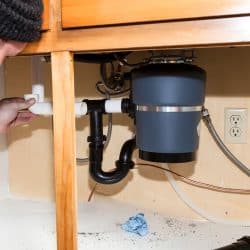Confirmed Solutions for Fixing a Dripping Garbage Disposal
Confirmed Solutions for Fixing a Dripping Garbage Disposal
Blog Article
Each person has got their unique way of thinking involving Why Is .

Waste disposal unit are important kitchen area devices that aid in disposing of food waste successfully. Nevertheless, a dripping garbage disposal can be a frustrating and messy issue to manage. Thankfully, several leakages can be fixed quickly with a couple of simple steps. In this write-up, we will certainly discuss just how to fix a leaking garbage disposal effectively.
Introduction
Garbage disposals are mounted under kitchen area sinks and are made to shred food waste into smaller sized pieces, allowing it to go through the plumbing system easily. While these gadgets are typically dependable, leakages can occur with time because of wear and tear, loosened links, or damage to the system.
Typical Causes of Leaks in Trash Disposals
Worn Seals and Gaskets
Seals and gaskets play an important role in preventing water from leaking out of the garbage disposal. In time, these parts can degrade, leading to leaks around the disposal system.
Loose Connections
The connections between the waste disposal unit and the plumbing system can end up being loosened with time, creating water to leak out during operation.
Splits or Holes in the Disposal Unit
Physical damage to the waste disposal unit, such as fractures or holes in the real estate, can also cause leakages.
Determining the Resource of the Leak
Prior to trying to deal with a dripping garbage disposal, it is important to determine the resource of the leak. This can typically be done through aesthetic evaluation or by performing easy examinations.
Visual Assessment
Check the garbage disposal system thoroughly for any type of indications of water leak. Pay attention to areas around seals, gaskets, and link factors.
Checking for Leakages
One way to examine for leakages is by running water with the disposal system and looking for any type of noticeable indicators of leakage.
Tools and Materials Needed for Dealing With a Leaking Garbage Disposal
Before starting the repair work process, gather the necessary tools and products, including a screwdriver, adjustable wrench, plumbing's putty, replacement seals or gaskets, and epoxy or patching material for fixing fractures or openings.
Step-by-Step Guide to Taking Care Of a Leaking Waste Disposal Unit
Shut off the Power
Prior to trying any type of repair work, make sure that the power to the waste disposal unit device is shut off to stop the danger of electric shock.
Situate the Leakage
Identify the specific place of the leak and figure out the reason.
Tighten up Links
Make use of a wrench to tighten any kind of loose links between the disposal unit and the pipes system.
Replace Seals or Gaskets
If the leakage is because of worn seals or gaskets, remove the old parts and change them with new ones.
Patching Cracks or Openings
For fractures or holes in the disposal system, usage epoxy or a suitable patching product to seal the broken area.
Examining the Garbage Disposal After Repair Work
Once the repair work is complete, check the garbage disposal by running water via it to make sure that the leak has been solved.
Preventive Maintenance Tips to Avoid Future Leakages
To prevent future leakages, it is important to carry out regular maintenance on your garbage disposal. This consists of maintaining it clean, avoiding placing non-food products or tough things down the disposal, and periodically looking for leaks or various other issues.
Conclusion
To conclude, fixing a dripping waste disposal unit is a reasonably straightforward procedure that can be completed with basic devices and products. By complying with the steps described in this post and exercising preventive maintenance, you can maintain your waste disposal unit in good working condition and prevent pricey repairs in the future.
HERE’S HOW TO FIX YOUR GARBAGE DISPOSAL
WHAT TO DO IF SOMETHING IS STUCK IN YOUR GARBAGE DISPOSAL
If the impeller won’t turn, there’s probably something stuck in the disposal. It could be a steak bone or peach pit, although plumbers report pulling all sorts of inappropriate objects out of disposals, such as bottle caps or aluminum foil. Make sure power to the disposal is off, and look inside to see if you can see the source of the jam.
Never stick your fingers in a disposal. Pull out anything you see with tongs or pliers.
If the disposal still won’t work, it may be time to call a plumber or consider buying a new disposal. GEM Plumbing & Heating is here for all of your garbage disposal needs.
WHAT TO DO IF YOUR GARBAGE DISPOSAL DRAIN IS CLOGGED
Take everything out from underneath your sink and put a bucket or other container under your disposal to catch any water that drains out. Disconnect your disposal from the power supply. If it’s plugged into a wall outlet, unplug it. If it’s hardwired into an electrical box, go to the electrical panel and turn off the breaker for the disposal. Pour ¼ cup of baking soda into the drain, followed by ½ cup of white vinegar. Give the solution a few minutes to fizz and do its work. Look into the disposal with a flashlight to see if you can see an object that might be causing the clog. If you see it, remove it using tongs or pliers. MORE TIPS ON DEALING WITH A CLOGGED GARBAGE DISPOSAL
Never use drain cleaner in a garbage disposal. It can damage the plastic parts inside the disposal. You can also be splashed with the caustic liquid while working to clear the clog. Beware! Never stick your fingers into a garbage disposal. Trust us — not a good idea. In many instances, your dishwasher drains through your garbage disposal. This allows the disposal to grind any large food particles that may be drained out of your dishwasher. There are some jurisdictions, however, where the plumbing code prohibits such a connection. WHAT TO DO WHEN YOUR DISHWASHER DRAINS THROUGH THE DISPOSAL
Run some water in the sink so your plunger has at least a ½-inch of water to create a seal and plunge vigorously up and down several times. You may need to repeat this several times. Run hot water down the drain to clear any residue that remains.

I was made aware of that report on Why Is through someone on a different web page. If you liked our post kindly make sure you remember to share it. Many thanks for your time. Visit again soon.
Call Us Now Report this page